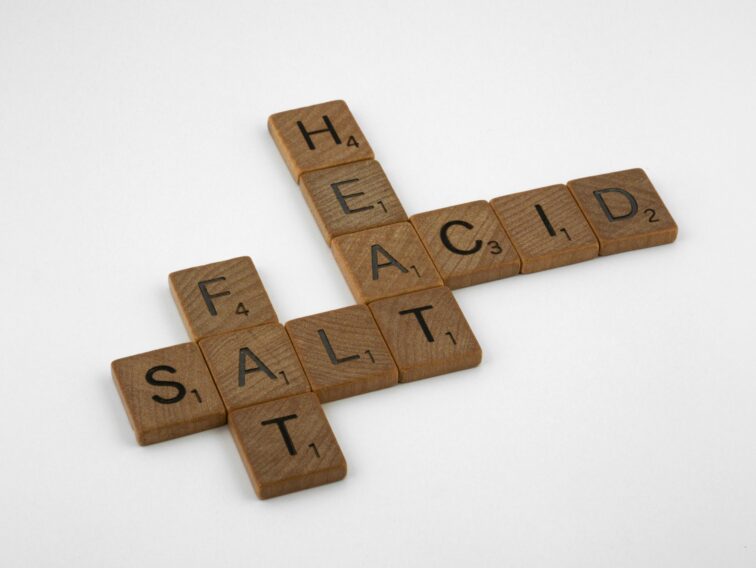In my experience, low stomach acid and depleted adrenals are among the top causes for gut infections and overgrowths like SIBO, LIBO (large intestinal bacterial overgrowth), yeast and parasites. Which lead to a leaky gut and rampant inflammation. This is what most doctors write off as IBS and prescribe meds that don’t address the real issue.
Addressing these two common root causes can give your body energy to heal, improve digestion and rebalance your biome. Bye-bye bloating!
Why stomach acid & adrenals matter
Stomach acid is the first line of defense against pathogens that enter our body. It also helps us digest our food. Undigested food particles (particularly carbs) become food for yeast, bacteria and parasites, fueling infections and overgrowths.
In other words, low stomach acid means more bacterial overgrowth.
Adrenals produce cortisol, which tames and balances inflammation and blood sugar levels in the body.
When blood sugar, inflammation and stress are high for a long time, the adrenal glands get tired of over-producing cortisol to “put out the fire” . When adrenals struggle to produce cortisol, high blood sugar and inflammation go unchecked and stress intolerance occurs.
This is why, good adrenal function and strong stomach acid are primary defenders of our digestive health. We must support both to recover and stay healthy.
The first step to troubleshooting this issue is to measure the function of the adrenals and the strength of stomach acid.
Testing stomach acid
There are many signs of low stomach acid and they vary. A few examples of possible symptoms include reflux or GERD, food sensitivities, bloating, infections, fatigue, skin issues and nutritional deficiencies.
There are three ways to test stomach acid. The first one is invasive.
The aspiration test involves placing a tube (endoscopic or nasogastric tube) in the most lower part of the stomach. Most doctors won’t prescribe it unless symptoms are severe.
The other invasive test is the Heidelberg pH test. It’s a procedure available in Portland, Oregon (and a few other places) which directly measures the acidity of the stomach. The test involves swallowing a small capsule about the size of a vitamin capsule, which is attached to a thin thread. Contained inside the capsule is a radio frequency transmitter. The capsule enters the esophagus and then the stomach, where it measures the pH level.
This non invasive option is, unfortunately, not very accurate. It’s the baking soda test.
First thing in the morning, you drink a spoonful of baking soda in water and time how long it takes to burp. It is easy and inexpensive but it is not reliable.
The third way to test for stomach acid is through the hair tissue mineral analysis test (HTMA). The building blocks of stomach acid are minerals such as sodium, potassium, cobalt and zinc. If you are low in these minerals, you can’t produce enough stomach acid.
The HTMA is a good way to test for stomach acid levels because it shows what minerals need to be supplemented for the body to produce more stomach acid. It also measures the state of the nervous system. Another reason for low stomach acid is a body that is in chronic fight or flight.
An h. pylori test can also help determine if stomach acid production is low. H. pylori is a bacterial infection of the stomach, that often lowers acid levels to create an environment for it to thrive in. Having H. pylori often means a less acidic stomach.
Many of the H. Pylori tests at the doctor’s office are not reliable. They often produce false negatives. The most accurate test for H. pylori is the GI Map.
I offer both the HTMA and the GI MAP to help my clients find the root cause of their digestive issues.
A great test for adrenal function
While there are many test for adrenal function, the HTMA test tell us why the adrenals are out of balance.
The cortisol spit tests graphs cortisol levels throughout the day. You may know if cortisol is too low in the morning or too high in the evening, but not what drives the imbalances from a physical level. Or how to support these imbalances.
Many of the same minerals that support stomach acid also are vital for the adrenals.
The HTMA measures sodium, potassium, calcium and magnesium, which play a pivotal role in adrenal function.
The adrenals are regulated by sodium and potassium levels and the state of the nervous system also plays a big role in adrenal function. The nervous system is supported by calcium and magnesium.
If these 4 primary minerals are low on the HTMA test, it signifies burned out adrenals..
And mineral levels also measure metabolic oxidation rates which tells us about the speed of thyroid and adrenal function.
The benefits of mineral testing
I added the HTMA test to my practice because it provides crucial information about systems that gut tests don’t even measure.
You can address bacterial, fungal or parasitic overgrowth with herbs, and clear them. But it you don’t dial in adrenal function and stomach acid, the gut will return back to it’s original baseline eventually.
Minerals are not often discussed in a world that focuses on killing pathogens and bacteria. Lowering overgrowths and attacking pathogens is only part of the picture.
Creating a strong body that can fight off invaders is more important. And that is hard to do when minerals are depleted. Low minerals means low energy to heal.
Low minerals also mean that the mitochondria is not getting cellular support. I will cover the importance of mitochondria in future blog posts.
Metabolism and gut health
Metabolism is highly influenced by mineral balance. Minerals are the backbone of thyroid function. Selenium and iodine in particular.
The metabolic environment the biome lives in is just as important as the biome itself. It is important to see the whole picture of health, not just zoom in on gut function.
We want to know the status of the immune system, blood sugar, adrenals, stomach acid, hormonal balance and the nervous system, because the gut relies on these.
I have seen too many people try to solve metabolic, adrenal or nervous system issues with antimicrobial protocols. They do this because they don’t know any better and it seems to make sense to address the threat.
We can’t just pull the weeds constantly, we must tend to the soil they grow in.
We must look at the root causes of these overgrowths.
Because, you can keep killing gut bugs, but if you don’t change the environment they live in, they will come back.
The HTMA helps us understand why the body is depleted or burned out, and shows us what we can do about it. Even people who don’t identify as stressed can have burned out or depleted minerals or adrenals.
The bottom line is that addressing infections without making sure that the adrenals and stomach acid are working well can be an uphill battle.
If you have been doing killing protocols but not having success, it may be time to look into these two common root causes.
Creating the right healing environment in the body can make all the difference.


